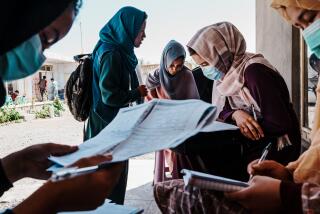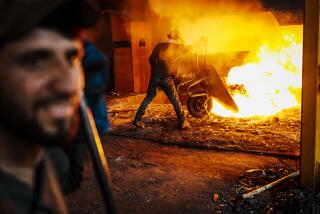Our Men in Kabul
- Share via
KABUL, Afghanistan — From a table in the dining room of the Herat restaurant on Barkesharenow Street, you can see the future. No, two futures.
The Herat has three rows of tables with chipped Formica tops. The kebab grill outside sends occasional plumes of savory smoke into the dining room. A television set blares Pakistani and Afghan music videos, and stacks of Pine Light cigarettes decorate the counter--modern amenities unseen six months ago. “Taste the American Experience,” the cigarette packs say. My translator is disappointed to learn they are not in fact from America.
Since the Taliban was swept away, the Herat has served a conglomeration of customers reminiscent of the bar scene in “Star Wars.”
But if one looks carefully at its unlikely collection of customers, they turn into human tea leaves:
There are diplomats, United Nations officials and NGO workers--along with their Afghan counterparts--working to rebuild a 23-year-old, war-blasted infrastructure. They represent the reasonably bright future Afghanistan could have.
There are young Afghan men of indeterminate rank and allegiance with Kalashnikov rifles--harbingers of the violent chaos ahead if the first group fails.
Finally, there are the young Americans in Gore-Tex jackets and Nike shoes who say vaguely that they are “engineers” come to help with reconstruction. Some are in fact Army soldiers working on roads and such. Many, however, those with no license plates on their new Toyota Land Cruisers, belong to the U.S. “special operations” forces. And this part of the Herat crowd--what they do and how they do it--may determine which future Afghanistan actually has.
In military terms, “special operations” is the huge, untold story from the U.S. war effort. Working in close cooperation with U.S. airpower, U.S. Army special forces toppled a repressive regime and put the Taliban and its Al Qaeda allies to flight.
Without question, the Army Green Berets, the Navy SEALs, the Air Force Special Tactics commandos and forward air controllers, the mysterious “Delta Force” and similar units from eight different nations took the greatest risks and achieved the greatest gains. They are also at the center of the continuing hunt for Al Qaeda members and the Taliban.
The question, however, is whether these Army Special Forces units and the high priority assigned to their missions still serve the best interests of the United States--or Afghanistan.
Three weeks of traveling across this complex and troubled country have left me wondering whether American policymakers are focusing in the wrong direction and neglecting what matters most: making sure Afghanistan never again harbors global terrorists.
One problem is that, with the Taliban overthrown, the James Bond aura of the special operators seems to convey exactly the wrong message. Dating back at least to special operations in Bosnia-Herzegovina and Somalia during the 1990s, a no-rules creed has developed among these units. Their members dispense with uniforms, grow beards and long hair. Commanders believe these changes in traditional military culture have helped the special operators do their jobs in a chaotic post-Cold War world. They may be right in military terms.
Yet, in a land dominated by warlordism and unruliness, the special operations culture projects an image that is the opposite of the orderly, by-the-book society Americans need to promote. And don’t these now-transparent disguises feed the conspiracy theorists who claim some American hidden hand is trying to take over or keep a particular faction in power?
Wouldn’t it make more sense, in all but the most sensitive military situations, for American soldiers to wear uniforms and project a professional military bearing?
Consider the U.N.-authorized International Security Assistance Force (ISAF), the peacekeeping army dominated by Britain and other Europeans--and decidedly not including Americans. ISAF units patrol Kabul’s streets in regular uniforms and clearly marked vehicles. They convey confidence and security as they help enforce the 10 p.m. to 4 a.m. curfew.
Other than ISAF, one doesn’t see too many foreign soldiers wearing uniforms anywhere in Afghanistan. The 5,000 or so Americans of the U.S. Army’s 10th Mountain and 101st Airborne Divisions, the Marines and the logisticians and support personnel are largely garrisoned forces. They travel by helicopter and mix with their Afghan proxy armies, not local civilians.
Beyond the image, continued emphasis on special operators presents other problems. Press reports--whether or not entirely accurate--have blamed them for a string of errors that threaten to overshadow their accomplishments:
The convoy attack outside Khost on Dec. 20, which ostensibly killed tribal elders on their way to Hamid Karzai’s inauguration; the attack in Hazar Qadam Valley on Jan. 24, which killed 16 persons the U.S. Defense Department now acknowledges were not Al Qaeda or Taliban; and the Feb. 4 drone-guided missile strike near Zhawar Kili, which seems to have killed three scrap-metal collectors, though the Pentagon still says they were not innocent.
The point here is not to indict special operators as heedless cowboys. Measured against the carnage Afghanistan has seen over the last two decades, these incidents are practically modest. And up to a point, they may be the unavoidable byproducts of a continuing effort to root out hostile fighters.
After all, the Taliban still exists; tens of thousands of its members have melted back into society. Also, the Taliban’s fight to power, its anti-technology fanaticism, its five-year civil war with the Northern Alliance and other anti-Taliban factions, coming on the top of 10 years of Soviet occupation and fighting, inflicted damage that makes the negative effects of American actions trivial.
But that is the past. What will determine the future is what happens now.
President Bush has never been comfortable with “nation building.” Gen. Tommy Franks, the U.S. commander, has made it clear the U.S. mission is to get Al Qaeda and its affiliates, nothing else.
In fairness, nation-building, in the sense of turning Afghanistan into a modern, Western-style society, is probably impossible anyway. From villages on the Shomali plain to the cities of Kabul, Kandahar and Mazar-i-Sharif, the destruction of war is everywhere. Old-fashioned, low-tech conflict produces cruder, broader destruction than “smart” weapons.
Nature has added to the devastation; so have a desperate people. Rivers have dried up from drought. Trees have been cut down for firewood. Systematic farming has stopped.
What is left is a dazed and dislocated population struggling to meet essential needs.
It is here, in the transition between military victory and whatever comes next, that the United States needs to think more clearly. What it is doing now may not achieve lasting results.
The American soldiers working on reconstruction are following a tradition that dates back to the post-World War II occupation in Germany and Japan, a tradition that is both laudable and laughable when translated to present-day Afghanistan. It has none of the technological or social foundations that enabled Europe and Japan to rise from their own ashes. And the U.S. commitment here is uncertain at best.
The soldiers involved in rebuilding are doing good deeds, but their efforts pale in comparison with those of the larger number of NGOs operating in Afghanistan. The latter were in the country before the Americans came and will likely remain long after President Bush pulls the plug.
This is not nation-building, with its implication of near-permanent involvement in another country’s internal affairs. This is about doing a few things right--and avoiding a few mistakes--that together could make a difference.
There is a widespread feeling among NGO workers that the United States is focusing too much on purely military matters. They are right. In the long run, for instance, the status of the family and the position of women in Afghan society seem more central to this country’s future than just about any military goal.
I know the tough retort is that “security” must come first. Yet, everyone agrees foreign forces on the ground are insufficient to impose security. More U.S. ground troops do not seem likely. And special operations forces cannot do the job. So, when it comes to security, there seems to be a hole in U.S. policy.
Meanwhile, the “special operators” who have taken up outposts throughout Afghanistan--in cities, and at “strategic” sites such as the Kajaki Dam north of Kandahar--remain on call to respond to tips about Al Qaeda and Taliban outlaws. They are the American eyes and ears, but they are dependent on local leaders and host governments that are self-interested, and hold only tentative and perhaps temporary power.
A bad incident, an increase in local instability, and the special operators could be extracted and whisked home as quickly as their brethren in Somalia were after the ill-fated mission that produced the book and film “Black Hawk Down.”
At the Herat restaurant, the young men with Kalashnikovs sit and wait. They will go whichever way the wind blows. They understand force and little else.
The danger is that Washington will continue to believe in the primacy of the hunt for terrorists and place its emphasis on the hard men in Gore-Tex and Nikes at the cost of the non-military challenges. If it does, then the United States could finish its “task” and still find itself back in Afghanistan very soon--trying to root out new disciples of fanaticism in a land that has little else to offer.
More to Read
Sign up for Essential California
The most important California stories and recommendations in your inbox every morning.
You may occasionally receive promotional content from the Los Angeles Times.










